. .
TUESDAY
APRIL 30 - 2019
Nightingales
at Marlpit Lane
Jo Bray heard
one, possibly two, Nightingales singing yesterday
afternoon, albeit briefly. Jo parked in one of the
lay-bys just beyond the turning to the works (facing
north). That's good news to hear that these iconic
birds have returned to their traditional summer
breeding area, despite the extensive works and
development that has occurred over the past few years.
I would appreciate any other hearings.
Millpond
ducklings
John Vickers
reports that thirteen Mallard ducklings hatched in his
garden in School Lane late afternoon yesterday. After
a night back at the nest site with their mother, and
two or three further excursions this morning, they
left via the garage and were escorted by local
residents down to the millpond, plunging straight in
'as a duck to water'. We wish them the best of luck,
they will need it as there are many hungry predators
in the area.
News
from Cuba
It is so good
to hear that Malcolm Phillips had a successful
wildlife photography exhibition in Cuba. He said it
attracted lots of visitors who said it was the first
time they had ever seen photos of birds on show;
previously photos were always political.
Malcolm is in the
centre with the checked shirt


Malcolm has also been
asked to visit a day care home to show the photos and
next week he goes to a cigar factory to talk and show
the photos. Well done Malcolm. He sends a photo of a
Yellow-Crowned Night Heron.

Selborne
Cuckoo disappears
Keith Betton
reports the sad news that the Hampshire Cuckoo named
'Selborne', sponsored by HOS since 2016 has
disappeared off the radar. The BTO last heard from
Selborne's transmitter at midday on 4 April when he
had just arrived in Spain. Unfortunately it looks as
if he died overnight 4 - 5 April. His last location
shows him over a southern ridge of the Sierra Morena
mountains and it looks as if he was stopped suddenly
in his tracks as he topped that slope. We will
probably never know what happened to Selborne but it
would appear most likely that he was either taken by
an avian predator or succumbed to human hunters.
Selborne was ringed in the New Forest in the summer of
2016 and named by the HOS members that year. Since
then we have followed Selborne over two complete
migration loops from Hampshire to his wintering
grounds in Gabon. He was only 1,430 Km (888 miles)
from completing his third migration loop.
He was an impressive Cuckoo - and always the first of
the tagged birds to head back home. We will summarise
his story in Kingfisher in July.
Keith added . . .
There are all kinds of possibilities and none can be
ruled out.... such as tag failure or tag loss. He
might also have simply died from his big flight and
perhaps with too little food. The BTO takes the view
that predation of some kind is the most likely. I'll
ask them to give more background if they can.
MONDAY
APRIL 29 - 2019
Brook
Meadow
Main news of
the day from Brook Meadow is the arrival of at least
two and probably three singing Whitethroats. I
heard the first one singing from the top of the tall
Crack Willow tree on the west side of the north meadow
where I managed to get a distant photo of it. Welcome
home.

I heard a second one
on the east side of the north meadow near the Lumley
copse, though it is possible that this was the same
bird moving across. A definite third Whitethroat was
singing strongly from the large bramble bush
immediately north of the causeway - perfect nesting
habitat for this bird.

They are a little
earlier than last year, but a few days later generally
than in previous years. The good thing is that they
have arrived safely, having travelled far from their
wintering grounds in Central Africa to be with us.
Well travelled.
It was also good to
see one of our resident Carrion Crows gleaning
for insects on the Lumley area. Carrion Crows are ever
present on the meadow and an important part of the
ecosystem.

Plants:
The large
Ash on the railway embankment is now sprouting
leaves, but sparsely. There has been no flowers at all
this year.

Newly flowering are
Wintercress at the junction of the north-east
path and the path across to the north bridge,
Meadow Buttercups in the orchid area to
supplement the Creeping variety that have been out for
a week or two, Ribwort Plantain also on the
orchid area and Common Sorrel on the centre
meadow.
The Ransoms
that Dan Mortimer planted last year in the north-east
corner near the grass cuttings are in flower again.
Dan has cleared the area around them.

What I think is
Slender Spike-rush (Eleocharis
uniglumis) is now out in the centre of the Lumley
area where it has been found in previous years. I
checked the lower glumes of which only one showed a
spikelet. In Common Spike-rush (Eleocharis palustris)
both lower glumes will be empty.
The clump of Remote
Sedge on the path through Palmer's Road Copse has
just started to flower. So far this year I have logged
8 of the regular 14 sedges on the Brook Meadow list.
A hoverfly -
possibly Syrphus ribesii and a
multi-spotted Harlequin Ladybird.
Part of the
observation fence in Palmer's Road Copse has been
damaged for some weeks. It not only looks bad, but it
opens up the river bank to trespass. It needs
repairing.
Hermitage
Millponds
The pair of
Canada Geese were on Peter Pond this morning being
relentlessly pursued by the cob swan. Meanwhile the
pen swan continues to incubate her eggs. I wonder how
many?

Common Vetch
and Wood Speedwell are in flower on the edge of
Peter Pond in front of Gooseberry Cottage. Note the
distinctive spike at the tip of the leaves. Wood
Speedwell has hairs all round the stem as
distinguished from Germander Speedwell which has two
lines of hairs down each side of the stem.
The Lillywhite's patch
south of Gooseberry Cottage has been cut and partially
cleared. With what purpose I wonder?
Over on Slipper
Millpond the Canada Goose pair are still nesting on
the centre raft and the Great Black-backed Gulls on
the south raft.

Bridge
Road Wayside
Newly
flowering on the wayside are Common Sorrel and False
Fox Sedge.
Barren
Brome is abundant on the wayside and looks so
attractive with its panicles swaying gently in the
breeze.

SUNDAY
APRIL 28 - 2019
Baffins
Pond cygnets
Eric Eddles
managed to snap the complete Mute Swan family on
Baffins Pond this morning with 7 gorgeous cygnets. The
Emsworth pair are way behind the Baffins duo. Nice
one, Eric.

SATURDAY
APRIL 27 - 2019
Late
news
Christopher
Evans had two Spoonbills at Medmerry on April 25.

Eric Eddles saw the
first cygnets of the year on Baffins Pond yesterday.

Derek Mills got this
cracking shot of a Magpie chasing a male Kestrel at
Pulborough Brooks today

THURSDAY
APRIL 25 - 2019
Garden
Egret
The Little
Egret was back on the wall at the end of the garden
for the second day running. This time I was ready for
it with my camera at the ready. I got a rather nice
zoomed photo of it through the window with its plumes
blowing in the wind. To think about 20 years ago I
went to Spain hoping to see a Little Egret; now I have
one in my back garden. How times have changed!
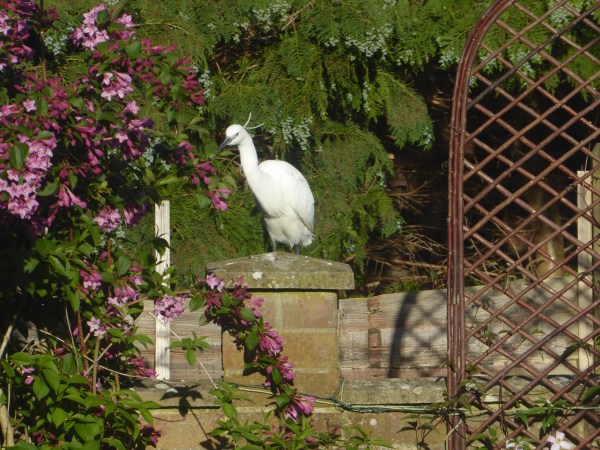
A pair of
Mallard are also regular visitors to the garden,
having come over the wall from the stream at the end
of the garden. They are quite fun to have in the
garden; sometimes two males turn up in pursuit of the
female. They also do a good job of cleaning up seeds
dropped from the holders hanging on the cherry tree.
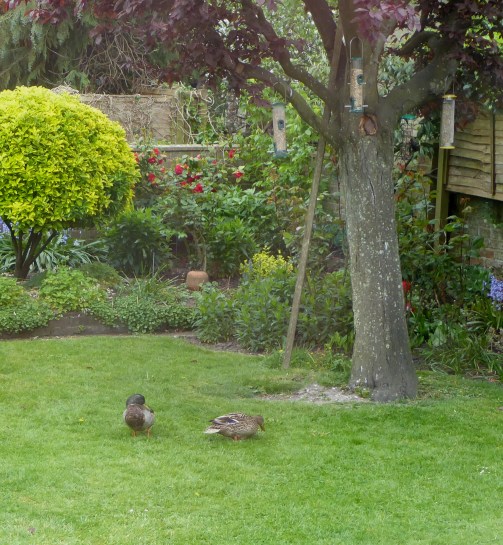
WEDNESDAY
APRIL 24 - 2019
Brook
Meadow
I went over to
the meadow this afternoon mainly to have a look at the
spot where Chris Luna thought he saw a Water Vole
yesterday. All I saw was a Brown Rat scrambling
through the brambles on the river bank. This is not
Water Vole behaviour. A Water Vole would be more
likely sitting low on the bank near the water's edge,
nibbling vegetation. The area in question is just
beneath a large Hawthorn bush which is just coming
into blossom. Behind it is the tall metal fence which
has sheds and lots of car rubbish behind it - a good
habitat for rats. I hung around for about 15 mins, but
saw nothing else. I think Chris was mistaken about the
Water Vole, but it is easy to do.
I posted a query about
the poor state of the large Ash tree on the railway
embankment onto a Facebook Group specialising in
wild flowers and I had lots of replies.

The general opinion is
that Ash is generally very slow coming into leaf this
year all over the country and well behind Oak, so not
to worry! The lack of flowers is more puzzling. One
respondent thought the lack of flowers could be due to
the tree changing its sex! I noticed leaves had not
really opened properly on the younger Ash trees near
the main seat, so maybe Ash is generally slow.
I had a look for
insects on the nettle leaves along the main river
path. I saw two Ladybirds with quite different
patterns of spots. The first with multiple spots and
prominent white 'cheeks' is one of the common colour
variants of Harlequin Ladybird. The other looks
like one of our native 7-spot Ladybirds -
probably the most common of the various Ladybirds.
I also saw what I
think is a Marmalade Hoverfly (Episyrphus
balteatus) with its typical abdomen pattern
showing through its translucent wings. Also several
Nursery-web spiders (Pisaura mirabilis)
Fnally, I picked up a
nice Woodpigeon feather on the causeway.

Garden
Egret
While I was
out on Brook Meadow this afternoon we had a Little
Egret visiting the garden. My wife grabbed my spare
camera and took some distant (unzoomed) shots of the
bird perched on one of our new Willow trellis panels
which was rather nice to see. We do get fairly regular
sightings of an Egret on the back wall which overlooks
the Westbrook Stream, but this one was especially
welcome as I wondered that we might not see it again
after seeing one dead in the stream, but all is well.
The Egret lives!

Langstone
Mill Pond
Peter
Milinets-Raby managed a quick 30 minute visit to
Langstone Mill Pond this morning from 9am to 9:30am.
His report follows . . .
The tide was out and
there was little water in the channel and consequently
there was virtually nothing to be seen except a single
Shelduck. As a result I concentrated on the Little
Egret colony, trying to establish a nest count.
I managed to count
18 certain nests, but with the foliage growing
up quickly and the impossible non visibility situation
with the main Holm Oak, it was difficult to gauge
numbers beyond this total. However, I suspect that
this very dense Holm Oak probably holds another 3 to 5
nests at least, bringing the current total to 18 to
23 pairs, which is only slightly down a few pairs
from last year. And, as yet, no Little Egrets have
nested on the island.
Other birds of note on
this shortened visit included just one pair of Tufted
Duck, 2 singing Reed Warbler, a singing Blackcap and a
couple of calling Mediterranean Gulls flew over. I
managed to get back to the car before the first rains
moved in.
Yesterday, the only
species of note were my first single Little Tern was
seen dashing along the Sweare Deep channel and there
were 10 Black-tailed Godwits, a Whimbrel and a summer
plumaged Greenshank on the low tide mud.
TUESDAY
APRIL 23 - 2019
Brook
Meadow
The large
Ash tree on the railway embankment has a number of
leaf buds bursting, but no flowers. Flowers should but
out before the leaves which suggests to me that
something a seriously amiss with this tree. Could this
be Ash die-back? I will make inquiries.
Purple flowered
Common Comfrey is out at the southern end of
the north meadow.

Divided Sedge
is now in flower and widespread on the Lumley
area.
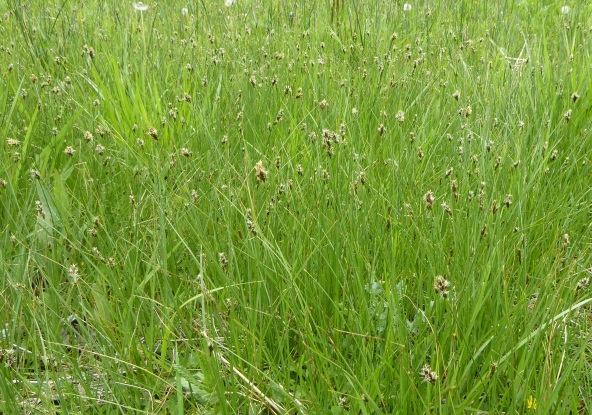
Today I also found a
good crop of Glaucous Sedge in much the same
central area as in previous years.
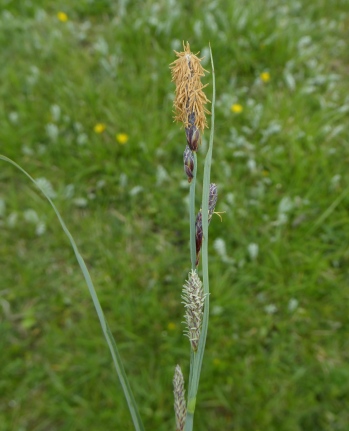
Hermitage
Millponds
There has been
a small fire along the edge of the path leading to
Gooseberry Cottage from the main road. A section of
the grass verge has been burnt along with some of the
reeds on the west side of the pond. The fire is not
extensive and looks as if it was extinquished quickly,
but it could have been serious if the reeds had
caught. The fire was very close to where the Mute Swan
is nesting.

Both Mute Swans
were at the nest in the reeds when I passed by at
about 3pm this afternoon. I could see 3 eggs in the
nest and there could be more. The tide was high at 3pm
but the nest was well above the level of the water.
There was no sign
of Canada Geese today and the raft held only
Black-headed Gulls and the resident Moorhen. Maybe the
geese have finally given up.
The large Laburnum
bush on the south side of Peter Pond next to the
road is in full flower and looks very fine indeed.

Meanwhile all was
quiet on Slipper Millpond with the nesting pair of
Canada Geese on the centre raft and one of the Great
Black-backed Gulls sitting on a nest of the south
raft.
Young
Blackbird
I was
delighted to see the first young Blackbird in the
garden this afternoon being fed by its parents. This
pair of Blackbirds have been regular visitors to my
feeding station for several weeks and I like to think
I have played a small part in providing the adults
with a regular food source.

Leaf
Cutter Bees
Last summer
Sue Thomas had a Leaf-cutter Bee (Megachile
Willughbeilla) making burrows in a pot of
succulents on an outdoor table and cutting and
carrying circles of wisteria leaves (see blog for July
30 2018). All winter Sue's two pots, have been in and
greenhouse and conservatory and today 5 bees emerged
in the conservatory which were carefully caught and
released - so now they have seen the whole cycle.
Here's Sue's photo of one of the bees struggling to
find its way out of the window.

MONDAY
APRIL 22 - 2019
Wayside
Cuckooflowers
I counted 102
Cuckooflowers on the wayside in Bridge Road car park -
down on last year's total of 157. In fact, numbers of
Cuckooflowers has been falling since I first started
counting in 2012 when we had a record 694. 2014 - 466.
2015 - 338. 2016 - 268. 2018 - 157. I suspect this
fall is due to the lack of regular mowing by the
Council which the wayside always used to have before
it became an official wayside. In fact, we have lost
many other interesting plants since the regular mowing
ceased. It might be useful to reinstate the regular
mowing, at least for a trial period. Strangely, we
have very few Cuckooflowers on Brook Meadow. The
habitat is clearly not to their liking.

Other
wayside news
Keel-fruited
Cornsalad is flowering as usual on the pavement on
the corner of St James Road.

Grasses now in flower
around the town include Meadow Foxtail, Barren Brome,
Soft Brome, Cocksfoot and Tall Fescue.
Cetti's
Warblers
We now have
two Cetti's Warblers on the Brook Meadow site: one was
singing strongly this morning in Palmer's Road Copse
and a second was singing from the copse north of Peter
Pond.
St
Marks Flies
While walking
through Brook Meadow this morning I came across swarms
of black flies around the Crack Willow trees on the
north meadow which I recognised as St Mark's Flies. I
see these distinctive flies at this time each year.
They are so called because they emerge around St
Mark's Day on 25th April. They fly around hedges,
grassland and woodland edges throughout the spring.
This was the best photo I could get today of the
insects in flight.

The shiny black males
have long dangling hind legs which you can just make
out in the above photo. Females are larger with with
smaller eyes and legs. Here is a nice photo I got a
few years ago on Brook Meadow showing a pair mating on
a nettle leaf. The male is on the left and the larger
female on the right.

Hermitage
Millponds
Despite what I
reported yesterday about the pair of Canada
Geese having been seen off Peter Pond by the swan
cob, well they were back on the raft on the pond this
morning, not seemingly nesting, but definitely back in
residence!

The pen swan was snug
on her nest in the reeds on the west side of the pond.
The nest has been built up well and is probably well
clear of the highest tides.

Peter's
migrant news
Peter
Milinets-Raby reports . . .
"The last three days have typically been a hard slog,
with each passing day the migrants have painstakingly
dripped out like the drops of juice being squeezed out
of a lemon. Looking back over my notes for the last
six springs, historically this drip, drip of migrants
is alas the norm.
The arrival dates for the regular and breeding summer
visitors for the area are surprisingly fairly
consistent. These breeding species In order of arrival
are Chiffchaff, Blackcap, Swallow, Reed Warbler and
Whitethroat. Nothing else breeds in the area, so
consequently any other migrant in the area in spring
is a big event!
Passing through the area (based on number of records
and arrival dates) are Wheatear (Only 4 spring
records), Whimbrel (Loads), Willow Warbler (Less than
20 in spring - ridiculously few in number, but
abundant on the return autumn passage), Cuckoo (just 4
records and none since 2015), Sandwich Tern (loads),
Sand Martin (Only 5 records), House Martin (Only 6
records), Yellow Wagtail (only 6 records), Sedge
Warbler (Just 3 spring records), Lesser Whitethroat (2
records), Pied Flycatcher (1 record), Common Tern
(loads), Redstart (2 records), Little Tern (Less than
25 records), Osprey (2 records), Common Sandpiper
(just 1) and finally Swift (always arrives late, but
less than 10 spring records).
That leaves a huge list of summer migrants that have
not been seen in spring, but recorded only once or
twice in autumn and these are Garden Warbler, Tree
Pipit, Hobby, Black Tern, Turtle Dove, Whinchat (only
5 records) and Spotted Flycatcher (6 records).
This morning was no
exception to the norm, with just a handful of summer
visitors seen, the best of them being 2 Common Terns
seen perched on a buoy out in the channel off
Langstone Mill Pond.
The full details of my outing this morning to the
Warblington shore and Langstone Mill Pond were as
follows (6:20am to 9:50am - very loooooow tide
throughout).
Warblington Castle Farm: 2 Swallows,
Ibis Field: 2 male Blackcap, 1 Chiffchaff, 4 Song
Thrush, 1 Moorhen, 2 Grey Wagtails, A pair of
Pheasant, 1 singing Skylark heard.
Heard in the distance from the cress beds was a
Cetti's Warbler. Another Cetti's was singing from the
stream along the hedgerow behind Conigar Point, along
with a Whitethroat and a Blackcap.
In the mini reed bed behind Conigar Point there was a
singing Reed Warbler.
The SSSI field held 2 Whitethroat.
From Conigar Point there were 9 Shelduck and 2 Med
Gulls.
Off Pook Lane: The aforementioned 2 Common Tern along
with a single Whimbrel on the mud (And a flock of 4
calling birds flew east along the channel and kept
going), a pair of Red Breasted Merganser a Lesser
Black-backed Gull and 4 Shelduck.
In and around Langstone Mill Pond: 3 pairs of Tufted
Duck (see photo)

There were 21 Little
Egrets present, but from the restricted views due to
the rich foliage growing up, new nest sites were hard
to determine. It looks like that the 11 nests I
counted the other day maybe all we are going to get
this year. I suspect there are probably up to five
more nests hidden away in the Holm Oak, but that is a
guess. There are as yet, no Little Egrets nesting on
the island.
The Grey Heron youngster in Nest 11 was flapping
wildly (see photo) and there appears to be only one
chick in Nest 4.

Also present were 2
singing Blackcap, 1 singing Chiffchaff, 1 male Reed
Bunting singing, 3 singing Reed Warblers with two
birds seen chasing each other though the reeds (There
were no Sedge Warblers singing). One singing Reed
Warbler had some wonderful bursts of mimicry that
included the odd Bearded Tit "ping" note and Yellow
Wagtail call intermingled with Swallow and Blue Tit. A
wonderful sound.
Orchids
and an Adder
Roy Ewing had
a cycle down to Gunner Point this afternoon to seek
out the Green-winged Orchids - and what a display!
Thousands, with many more to develop.

And on the way back
along the Hayling Billy line Roy had to swerve to
avoid an Adder in the middle of the track - just south
of the Oyster Beds. It eventually slithered to safety,
whilst Roy directed other cycles around it.
Approximately 30cm in length.

Roy also saw an Adder
here a couple of years ago, north of the Oyster Beds
and believes this area is a "hot spot" for Adders, so
will be extra cautious in future. I certainly agree
with Roy. The area around Hayling Oysterbeds has long
been known as prime area for Adders and I too have
seen one on a couple of occasions. What a great
sighting. Thanks Roy.
SUNDAY
APRIL 21 - 2019
Brook
Meadow
A very warm
morning for today's constitutional through the
meadow.
From the north bridge I walked north along the main
path to have a look at the large Ash tree on
the railway embankment that I have been concerned
about. I was interested to see some evidence of leaf
buds opening and at least one clutch of flowers, but
these looked rather weak. The flowers always come
before the leaves on Ash. Generally, the tree still
looks pretty sad, but while there is life there is
hope, I suppose.
On the river bank
opposite the Ash, I got a rather nice picture of a
Dock Leaf Bug (Coreus marginatus) on a
flower head of Cow Parsley. I was pleased with that
one.

A little further along
the north path I came across a tiny Wren having a
dust bath.
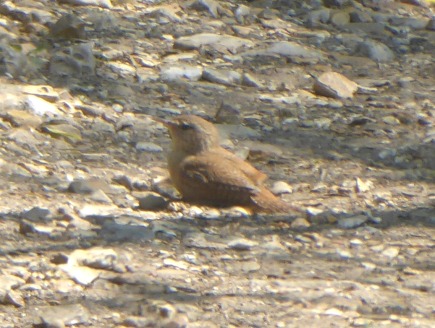
During the walk, I
heard four singing Blackcaps. 1. from the
brambles in the north west corner of the north meadow.
2. from the edge of the Lumley copse. 3. on east side
of the south meadow near the Lumley gate. 4. from
Palmer's Road Copse. I will keep note of these
possible nesting locations.
I was listening out
for early Whitethroat arrivals (Peter Milinets-Raby
had two at Warblington yesterday - see Peter's report
bewlow). There was no sound of any song, but they
should be here very soon.
There were not as many
butterflies as I might have expected on such a warm
(almost hot) morning, but male Orange Tips were
everywhere along with what I assume were white female
Orange Tips and some Small Whites. I also saw a couple
of Peacocks a Brimstone and a few Speckled Woods. What
was my first Holly Blue of the year settled
nicely for a photo in Palmer's Road Copse.

My first open flower
of Lords and Ladies showing the inner spadix was on
the path behind Lillywhite's Garage.

Peter
Pond news update
Dan Mortimer
has been keeping me posted on what he called 'the turf
war' on Peter Pond.
"On
Thurs afternoon the pair of Canada Geese completed
their nest and laid a couple of eggs and from then on
the cob swan spent the whole day chasing the geese
around the pond being the boss. The geese lead him a
merry dance swimming in every direction which confused
the cob with one of them always ending back on the
raft and the other goose swimming in the opposite
direction leading the cob a merry dance.
On Friday morning the cob swan got onto the raft and
chased off the sitting Canada Goose, exposing the 2
eggs. A Grey Heron swooped onto the raft after the
eggs only to be chased off immediately by one of the
geese. The nest was left empty for the rest of the
day.
Early Saturday morning one of the Canada Geese was
back on the nest, but the war continued with the cob
swan manically chasing the geese up and down the pond.
Later in the day the geese appeared to have given up
on their nest. Gulls (Herring or Great Black-backed)
had taken the eggs and the nest seems to be
empty."
This morning I saw no
sign of the Canada Geese on Peter Pond - and the nest
site on the raft was empty except for the regular
flock of Black-headed Gulls and one Moorhen.

However, I did spot a
Coot sitting on top of a 'tower nest' by the
reeds on the west side of the pond (close to where the
Mute Swan is nesting).

Langstone
Mill Pond
This morning
Peter Milinets-Raby had a pleasant two hour proper
bird watching visit to Langstone Mill Pond from 6:40am
via Wade Lane. Even though it was another mundane
migrant day, it was a great birding day. The
highlights with photos were as follows:
Wade lane:
2 Swallows perched on overhead wires and already
dashing into the open door of the pony stable. A very
confiding Mistle Thrush stuffing its bill with worms.
How do they add to the wriggling mass when the beak is
so full? It made several trips, taking the beak of
food to its nearby nest in the trees beside Wade
Court.
2 male Blackcap. 1
Whitethroat, Buzzard on the ground in one of the
paddocks, Med Gull over. Male Pheasant calling with
its comical call, like an explosive sneeze as it jumps
and flaps its wings and puffs itself up all at the
same time!
Langstone Mill
Pond:
Male and 2 female Teal still lingering - possible
breeders. male and female Reed Bunting - male singing
fairly close in the reeds, 4 Reed Warblers, Blackcap
heard singing, plus Chiffchaff. 2 male and 1 female
Tufted Duck, 18 Little Egrets present.
And all hell broke out
in the heronry when the male from Nest One chased off
the nest its four old siblings, the last one put up a
stubborn brat-like defiance with lots of submissive
postures until eventually flying off. The male then
displayed on the nest with plenty of neck raising and
puffing up its neck feathers. This pair always have a
second brood.
Terns
at Hayling Oysterbeds
Chris Cockburn reports that Common Terns have been
inspecting the Hayling Oysterbeds' Lagoon site where
some Black-headed Gulls are now laying eggs. It is
likely that,very timely, the large Common Tern raft
will be afloat in the next two weeks or so by when the
terns will be getting into breeding condition while
the vast majority of the Black-headed Gulls will be on
nest and not likely to take over the tern's provided
habitat.
Bluebells
and Orchids
Pam and Roy
Ewing did their annual pilgrimage to Racton Park Farm
to see the Bluebells this afternoon. Roy says
they were at their best, a few days earlier than last
year. A family group were having an Easter egg hunt -
a novel use for a bluebell wood!

On the way back they
stopped off at Hollybank Woods - the Bluebells are at
their best - rather better than I reported in this
blog on the 10th. Roy and Pam also sought out the
Early Purple Orchids - finding at least 100
spikes. Roy thought the orchids were moving
northwards, away from the areas they used to be.
That's interesting. I must check it out. Any other
views?

White
Stork at Nutbourne
Mandy Dridge
couldn't believe her eyes when she saw a beautiful
White Stork in the cow field at Farm Lane Nutbourne on
Friday 19 April. White Stork is a very rare bird in
this country, but there are fairly regular sightings,
including one by my friend Caroline French on Thorney
on Mar 24. It is could be the same bird. Has anyone
else seen one recently?

FRIDAY
APRIL 19 - 2019
Canada
Geese nesting on Peter Pond
A pair of
Canada Geese has been hanging around Peter Pond for
the past couple of weeks, much to the annoyance of the
cob swan. The pen swan has been on her nest in the
reeds for about a week. Well, this morning I saw one
of the geese sitting on a nest on the raft in the
centre of the pond. This would be the first time in my
memory that Canada Geese have actually nested on Peter
Pond. A pair has nested on the neighbouring Slipper
Millpond for the past three years, but not on Peter.
Dan Mortimer tells me there have been skirmishes with
the cob swan, so it will be interesting to see how the
situation develops.

Brook
Meadow
I had my first
Speckled Wood of the year in Palmer's Road
Copse.

Meadow Foxtail
grass is now well developed in patches. This is
always the first grass to show on the meadow.

I spotted a Stock
Dove tucked up in a cavity in one of the large
Crack Willow trees by the main path through Palmer's
Road Copse - possibly nesting? They do usually nest in
holes in trees with a small amount of vegetation
added. I often hear Stock Dove cooing song in the
copse, but have never actually seen a nest before.

THURSDAY
APRIL 18 - 2019
Brook
Meadow Workday
It was a fine
spring day for this morning's conservation work
session on Brook Meadow led by Colin Brotherston. Nine
volunteers were present for the group photo but others
arrived later.

The main tasks
involved clearing up the piles of trees cuttings
partly for the bonfire and partly for the log pile for
collection for home wood burners. Several volunteers
were engaged in moving the pile of wood chippings from
near the tool store in barrows to lay on muddy paths
on the east side of the north meadow. I moved around
taking photos of the work for the web site and noting
any wildlife of interest. We had a treat at the break
when Pam revealed a bag of hot X buns for us to have
with coffee. They were excellent. Dan is looking
forward to his!

A full report with
more photos is on the Brook Meadow web site at . . .
https://www.brookmeadow.org.uk/conservation-news/
Wildlife
observations
Several what I
assume were Small White butterflies were
fluttering around the meadow, but none stopped long
enough for close inspection. They are a couple of
weeks later than usual. Here is one taken last year.

There was a collection
of about a dozen blue Flea Beetles (Altica
lythri) on the nettle leaves on the main river
path. These are fairly common on the meadow in spring
time. They get their name from their ability to jump
when touched.
Nearby was a pair of 7-spot Ladybirds mating.
I saw dozens of young
Nursery-web spiders 'sunbathing' on the nettle
leaves along the main river path, some with front
pairs of legs held rigidly straight out in front of
them, others (less mature?) with their legs twisted
up. These spiders get their common name from the dense
silk nursery tent that the female builds for her
spiderlings. These are often seen dotted around the
meadow in summer, usually with the female standing
guard nearby.
While standing under
one of the Black Poplars I listened to the
sound of hundreds of tiny green seeds cascading down
onto the ground around me, hitting the ground like
tiny hail stones. The seeds were all over the ground,
resting on nettles and other vegetation. That confirms
my earlier speculation about these trees that they are
definitely female!
I am moving towards
the identification of our two Black Poplar trees as
'Florence Biondi' - 'straight stemmed, graceful
with fairly sparse foliage denser at the crown'
(Collins Tree Guide. p.158). Here are some young
leaves.

Dead-nettles
I had a close
look at the two Dead-nettle species which we have on
Brook Meadow both of which have very attractive
flowers when looked at closely. White
Dead-nettle is the more robust of the two plants,
standing tall, with white flowers arranged in well
spaced whorls. It has pointed heart-shaped leaves,
which could be mistaken for Common Nettle leaves but
they have no stinging hairs.
Red Dead-nettle is a smaller plant with whorls
of reddish purple flowers and rounded heart-shaped
leaves which are stalked. It also has no stinging
hairs, though its leaves are unlikely to be confused
with Common Nettle. I gather young plants have edible
tops and leaves, though personally I prefer to see
these lovely plants untouched in the wild.
I was interested to
learn recently that Red Dead-nettle occasionally has
white flowers, though I have not seen this aberration
myself. Henbit Dead-nettle is a similar plant to Red
Dead-nettle, but has unstalked leaves. Both
Dead-nettles are very ancient introductions to this
country and are now common and widespread.
WEDNESDAY
APRIL 17 - 2019
Warblington
shore
Peter
Milinets-Raby was up early for a short walk along the
Warblington shore ahead of an incoming tide from
6:24am to 8:19am.
In the Ibis Field were 41 Black-headed Gulls with 3
Med Gulls amongst them, along with singing Chiffchaff
and Blackcap and 2 Shelduck were flying around and
eventually landed out of sight on the cress beds.
The big field to the west had 2 male and 3 female
Pheasant, along with 2 Stock Doves and a Mistle Thrush
flew over.
In the hedgerow behind Conigar Point was a singing
Cetti's Warbler, a couple of Chiffchaff and a singing
Blackcap and in the field behind the point there was a
flock of 22 Linnets.
The mini reed bed held a singing Reed Warbler and a
calling Reed Bunting.
Conigar Point: 5 Shelduck, 1 Greenshank, 8 Whimbrel
circled around a couple of times before heading off
east along the channel.
Off Pook Lane I heard a Yellow Wagtail pass over
heading inland and out on the mud were 25 summer
Plumaged Dunlin, 14 Shelduck, a Black-tailed Godwit
and in the channel a Great Crested Grebe and a feeding
flock of one male and 7 female Red Breasted
Merganser.
At the farm were 2 breeding Pied Wagtails being
disturbed by a Sparrowhawk flying over.

EuroBirdPortal
viewer
The BTO
reports that EuroBirdPortal have just released a live
version of their online viewer. The new EuroBirdPortal
viewer shows the distribution of 105 bird species on
animated maps that are updated daily by adding around
120,000 observations from birdwatchers across the
region, including those from BirdTrack. These
observations allow a fascinating near real-time view
of the movements of birds such as the Swallow and
Cuckoo as they arrive in Europe from further south and
move north with the progression of spring. Well worth
a look.
Go to . . .
https://bto-enews.org/IG4-68L07-3RN36S-3K66RQ-0/c.aspx
TUESDAY
APRIL 16 - 2019
Godwit
ringing
Neil Foster
attended an enlightening presentation about Icelandic
Black-tailed Godwits given by Jenny Gill (of UEA) at
the recent HOS members' day. As Neil says, by now she
is probably in Iceland with Pete Potts recording the
returning birds! The results of their efforts are
marvellous. Having been involved with the Black-tailed
Godwit ringing project as a recorder of colour-ringed
birds for many years, I fully agree.
As I was not able to attend the HOS Conference, I
would like to thank Neil particularly for a link to an
excellent online Inaugural Professorial Lecture given
by Jenny Gill about her Black-tailed Godwit research.
This is simply fascinating research and shows the
value of colour-ringing the birds. Jenny's lecture
starts at about 12 minutes in. https://www.youtube.com/watch?v=KoTx4T1gSx4
Every
year, millions of birds undertake extraordinary
migrations, crossing oceans and continents around the
world. In this talk, Prof Jenny Gill from the UEA
School of Biological Sciences explains how tracking
individual birds on these journeys allows us to
uncover links between different breeding and wintering
grounds. She goes on to explore how changing
environmental conditions are driving population
changes in numerous species, many of which are in
sharp decline.
Here are a couple
of photos of Pete Potts at work in Iceland from my
files . . .
Pete listening for the
Godwits as they arrive

and ringing a
Black-tailed Godwit watched by keen youngsters

Here are a couple of
old friends I recorded in Emsworth Harbour a few years
ago
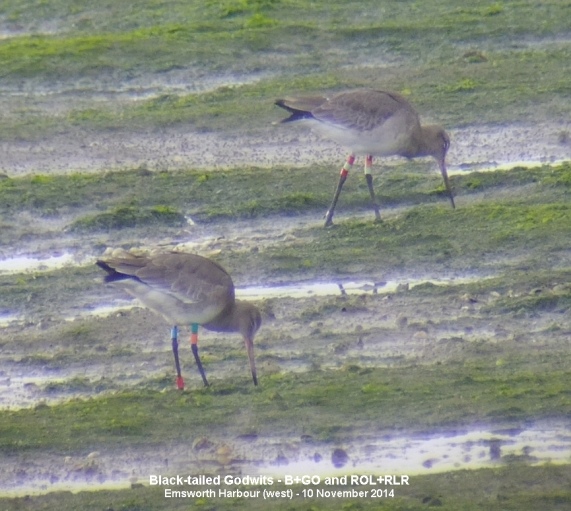
Mining/Carpenter
bees
Following our
discussion about Mining bees (april 12), I asked Bryan
Pinchen about bees in the Pallant Gallery in
Chichester where I am a volunteer which come out of
the woodwork in the old house each year at this time.
They call them carpenter bees. Or are they are mining
bees?
Bryan replies . . .
Mining bees are the ones that excavate their own nests
in the soil, carpenters tend to excavate their own in
wood, whereas the ones you speak of are utilising
holes created by wood boring beetles, I haven't come
across a 'generic' name for these, hence why I always
refer to all of them as 'solitary bees', which
in my mind eliminates any confusion.
Extra question: How
about Mason bees?
from Wikipedia.
This is a name now commonly used for species of bees
in the genus Osmia, of the family Megachilidae. Mason
bees are named for their habit of using mud or other
"masonry" products in constructing their nests, which
are made in naturally occurring gaps such as between
cracks in stones or other small dark cavities; when
available some species preferentially use hollow stems
or holes in wood made by wood-boring insects.
For
the previous entries go to . . April
1-15